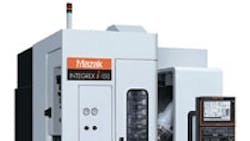Emerging in the 1980s, the early multi-tasking machine tools had limited machining center capability on a turning machine. Today, thousands of machines later, mindsets -- not machine capability -- can be among the limitations to overcome.
With multi-tasking the focus is on combining processes onto one machine tool -- processes that traditionally required multiple machines. The goal: to turn, mill, drill, tap, bore and finish a part in a single setup. "Done-in-one" is the descriptive mantra.
The advantages can be broad ranging, says multi-tasking pioneer Brian Papke, president, Mazak Corp., Florence, Ky. Users report the following strategic ways to benefit:
Launching the optimization process is enhanced -- and sometimes complicated -- by the rapidly growing variety of multi-tasking designs. For example, Mazak alone has more than 90 models and variations available. Other providers of multi-tasking equipment include Mori Seiki, DMG Nakamura-Tome, Citizen, Okuma and EMCO Maier.
In the Mazak lineup, the Integrex name identifies multi-tasking designs, but multi-tasking features are often included in other Mazak models. Examples range from the Quick turn Nexus at the low end (smaller parts, mainly turning with secondary operations front and back) to the Super Quadrex (4-axis turning, designed for high volume shaft work with secondary operations). Meanwhile the range of the Integrex multi-tasking models keeps expanding with the mix now including a range of sophistication and sizes in both horizontal and vertical configurations.
| Manufacturers Reach for the Payoff from Multi-tasking While multi-tasking machine tools cost more than conventional equipment and require special training, consider the ROI: "Multi-tasking machining can yield a 400% increase in productivity, whereas in the past four different machine setups were required," says CAM software provider Chuck Mathews, vice president, DP Technology Corp., Camarillo, Calif. Consider the experience of Greg Unmann, president, Astra Tool & Instrument, Hawthorne, N.Y.: a 60% cycle time reduction and significant quality improvement after consolidating multiple machining operations. It started with investing over $3 million in machine tools at the Coventry, UK, plant of Dunlop Aerospace Braking Systems, a part of Meggitt plc. To optimize "done in one" objectives, Dunlop specified the tool magazines to be equipped with Renishaw probes. Probing checks forgings (see photo above) for irregularities during setup, enabling best fit location of the part. That eliminates air cuts, enables cutting to start immediately and ensures that surfaces are accurately located, while reducing overcutting. |
Papke sees an expanding role for machine tool vendors to help customers develop, implement and maximize effective multi-tasking strategies. Accomplishing that at Mazak means maintaining an international perspective on customer connectivity via its 30 global technology centers.
Helping customers prove out production strategies and processes is the primary function of the centers. Papke says customer parts involved in the centers' process optimization can range from a small aluminum part for a medical equipment component to perhaps a large aircraft engine housing made of Inconel. "We bring together teams of application engineers and suppliers to help optimize and prove out a customer's process."
Helping customers establish and maximize effective utilization of their multi-tasking equipment is only part of the continuing role of the technical centers, adds Papke. He's referring to the operator training programs Mazak recommends to its customers. Mazak's multi-tasking operators also participate. The training at the centers also interfaces with suppliers and trade associations. Multi-tasking user groups also meet at the technical centers to share utilization experiences.
The Bigger Picture from Multi-taskingAccording to Papke, "Rethinking American manufacturing to make process change a reality should be the singular issue of our time for manufacturing technology providers. Real world examples are emerging and should be broadly disseminated to prove this is not theory.
See Also
